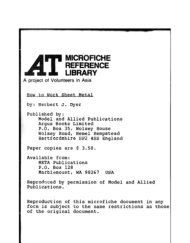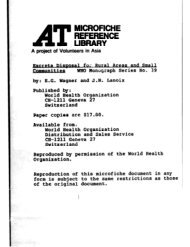Create successful ePaper yourself
Turn your PDF publications into a flip-book with our unique Google optimized e-Paper software.
L<br />
-w<br />
.<br />
H<br />
.<br />
COLOR’ IN ICELAND<br />
.~I;l,ll~~liA .HJ&rI14d$tir, tll~~~jiralidc<br />
,dni~~r of lslnndic cr:ifPts. 11~ written<br />
ii lwa2litiful book on weaving in Icelandic1<br />
hon~es. 1 t is called I-E’)ICIC?ILY (Menningars,jtids<br />
Puhlisheixl Reykjnvik, 1966).<br />
lf:lttJGtil nlrnfiL)ns that ill Ivrl:~nd all<br />
dycling Of yarn is done in the homes but<br />
that the natural colors of the wool are<br />
uwd very much for everyday wear. Many<br />
- pil’tures in her book show how the whites;<br />
g~lys, l~ro~vns and hlncks give fine color<br />
variations to woven artic!l&.<br />
Sillw Ilt:ic*k w~)l is in grr:lf d~~mnnd for’<br />
c~lotliing in Tcclnnd but the supply of<br />
f~:itulxll~~ 1)1:1(.1; wool is far fr0111 sullic-i.c*llt,<br />
fl1(1 I car*l:llldica ~VOIIIOI~ c*arrird OH :I<br />
1lwJ 5;trn~~l(~- until thlly found a way of<br />
dylll~r :1 I- good black by using their own<br />
Ii:lti?(a Iil;Ltcrinl.<br />
For Illany years something known as<br />
“tlll~ b#gh< ~‘hllt” (.s.or.f~) was t.rird, but<br />
.1 111~~ i~olor rlil~lrc~l ol’f. Rl~ick liiud front the<br />
hogs 4 ur)r!i r,/~tti) atltl also bearberry<br />
/ .I ).l”fI).~tfl(ll/!//rlb 111’(1-If)..\/), wliic~li is cilllrd<br />
.slJrtlrl~/rl~/<br />
in Iwl:liidic~, wwv uscad fill<br />
some time. They yielded a black dye, but<br />
it was ntlitht~r rltlep nor durnbl6. Finally it<br />
was discovered that the combination of<br />
blnc~k IIIII~ and hearberry gave a beautiful<br />
and fast black color.<br />
Astrid Swens’on<br />
The Iceland-moss (Cetraria<br />
‘-1<br />
cf. G.‘LvVenring -<br />
islandico),<br />
also called “mountain-grass” in Iceland,<br />
is widely distributed in northern countries,<br />
inchding the northern United<br />
States.<br />
to gray,<br />
It is a paper-thin/lichen<br />
olive-green &hen--wet,<br />
.‘_ .<br />
brown<br />
and is -<br />
fourid on both soil and ‘rocks in tangled<br />
masses. Beyond its use in dyeing, according<br />
to G. G. Nearing in his The<br />
Lichen Book, this lichen has been irqportant<br />
as food for humans a.nd animals.<br />
, -<br />
&digoLhas..heen imported. to $&&.L -e -.I -<br />
since the earIF 19th century for more a<br />
color-fast and clear blues than any native ‘8,<br />
plant could yield. It is used with urine as<br />
:I mordant in the old way,qen though in<br />
most other mestern countries ammonia is<br />
now substituted for urine, in similar dye- ’ .<br />
ing processes. In Iceland the blue from<br />
iudigb is called “stone-color.”<br />
, However, with all these ckors, n&ral .<br />
as well as dyed, the very. import&t red-<br />
“the queen’s color”-was missing. Icelan-<br />
(lice WOW& had tried for centuries to find _<br />
a Il;ttivc! plrlllt that wo$ld give a red color ,JZ<br />
slid, filliiil~, also in the rly 19th centud-. /<br />
their esperiments led to “&, a ‘scovery.<br />
First, the yarn was boiled w&h “fjulln- ”<br />
!/r.iis (iiioulitaiI1-grass)-the lichen Cetrcz-<br />
~icc i.sla&ick Then it was treated for a.<br />
muplt~ of weeks with stale nrinh from<br />
l)rcgnant cows (sometimes with a little of<br />
tllo national strong drink “black death”<br />
;iddcd to it). The result was what first 4as<br />
c~:~lld the “pow-urine red,? $iter, nal!xed<br />
.“Tcrlnndic 1lighArcd. ” The color is blukk<br />
Iwl, “the ki[2,scarlet.” ’ !<br />
Fiwrl note: In Sweden Cetraria islan- .<br />
dim is used with alum-mordanted /yarn<br />
and an ordinary<br />
brown coIors. +<br />
dyebath ‘for y+%vish-’<br />
,:<br />
‘,







